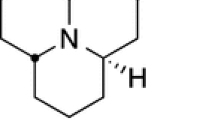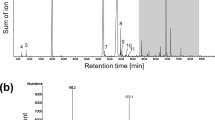Abstract
The absolute configuration of the iridoid monoterpene chrysomelidial from the oribatid mite, Austrotritia dentate Aoki, was elucidated by the GC-MS and GC comparisons with four synthetic stereoisomers of this well-known natural product. This identification was made possible by asymmetric synthesis of the known alcohol, (5S,8S)-chrysomelidiol. The GC retention time of diol derived from the natural oribatid dial agreed with that of the synthetic (5S,8S)-chrysomelidiol, confirming that the absolute configurations at C5 and C8 positions of the natural chrysomelidial are both S. Chrysomelidial was detected as a single or a major component in nine oribatid mites examined; thus, this compound is considered to be commonly distributed in Oribotririidae where it serves a defensive role.




Similar content being viewed by others
References
Bellesia, F., Ghelfi, F., Pagnoni, M., and Pinetti, A. 1986. The base-catalyzed cyclization of 10-oxocitral synthesis of chrysomelidial and dehydroiridodial. Tetrahedron Lett. 27:381–382.
Bernardi, A., Karamfilova, K., Boschin, G., and Scolastico, C. 1995. Enantioselective Michael-Mukaiyama additions of silylketene acetals to 2-carboxycyclopentenones promoted by chiral Ti complexes. Tetrahedron Lett. 36:1363–1364.
Bernardi, A., Colombo, G., and Scolastico, C. 1996. Enantioselective Mukaiyama-Michael reactions of 2-carbomethoxy cyclopentenone catalyzed by chiral bis(oxazoline)-Cu (II) complexes. Tetrahedron Lett. 37:8921–8924.
Bernardi, A., Karamfilova, K., Sanguinetti, S., and Scolastico, C. 1997. Enantioselective conjugate additions of silylketene acetals to 2-carboxycyclopentenones promoted by chiral Ti complexes. Tetrahedron 53:13009–13026.
Blum, M. S., Wallace, J. B., Duffield, R. M., Brand, J. M., Fales, H. M., and Sokoloski, E. A. 1978. Chrysomelidial in the defensive secretion of the leaf beetle Gastrophysa cyanea Melsheimer. J. Chem. Ecol. 4:47–53.
Enders, D., and Kaiser, A. 1997. Asymmetric synthesis of (R,S)-dehydroiridodial, (R,S)-dehydroiridodiol and analogues. Liebigs Ann. 485–493.
Kato, T., Wilson, P. G., Fujishita, A., and Frechet, J. M. J. 1990. Hydrogen- bonded liquid crystals. A novel mesogen incorporating nonmesogenic 4,4’-bipyridine through selective recognition between hydrogen bonding donor and acceptor. Chem. Lett. 2003–2006.
Meinwald, J., Jones, T. H., Eisner, T., and Hicks, K. 1977. New methylcyclopentanoid terpenes from the larval defensive secretion of a chrysomelid beetle (Plagiodera versicolora). Proc. Natl. Acad. Sci. U.S.A. 74:2189–2193.
Meinwald, J. and Jones, T. H. 1978. Synthesis and stereochemistry of chrysomelidial and plagiolactone. J. Am. Chem. Soc. 100:1883–1886.
Pasteels, J. M., Braekman, J. C., and Daloze, D. 1982. Chemical defense in chrysomelid larvae and adults. Tetrahedron 38:1891–1897.
Raspotnig, G., Kaiser, R., Stabentheiner, E., and Leis, H.-J. 2008. Chrysomelidial in the opisthonotal glands of the oribatid mite, Oribotritia berlesei. J. Chem. Ecol. 34:1081–1088.
Raspotnig, G., Leutgeb, V., Krisper, G., and Leis, H.-J. 2011. Discrimination of Oribotritia species by oil gland chemistry (Acari, Oribatida). Exp. Appl. Acarol. 54:211–224.
Sakai, T., Nakajima, K., Yoshihara, K., and Sakan, T. 1980. Revisions of the absolute configurations of C-8 methyl groups in dehydroiridodiol, neonepetalactone, and matatabiether from Actinidia polygama Miq. Tetrahedron 36:3115–3119.
Santangelo, E. M., Rotticci, D., Liblikas, I., Norin, T., and Unelius, R. 2001. Resolution of an iridoid synthon, gastrolactol, by means of dynamic acetylation and lipase-catalyzed alcoholysis. J. Org. Chem. 66:5384–5387.
Sugawara, F., Matsuda, K., Kobayashi, A., and Yamashita, K. 1979a. Defensive secretion of chrysomelid larvae Gastrophysa atrocyanea Motschulsky and Phaedon brassicae Baly. J. Chem. Ecol. 5:635–641.
Sugawara, F., Matsuda, K., Kobayashi, A., and Yamashita, K. 1979b. Defensive secretion of chrysomelid beetles. Part 3. Defensive secretion of chrysomelid larvae Linaeidea aenea Linne and Plagiodera versicolora distincta Baly. J. Chem. Ecol. 5:929–934.
Weibel, D. B., Oldham, N. J., Feld, B., Glombitza, G., Dettner, K., and Boland, W. 2001. Iridoid biosynthesis in staphylinid rove beetles (Coleoptera: Staphylinidae, Philonthinae). Insect. Biochem. Mol. Biol. 31:583–591.
Yoshihara, K., Sakai, T., and Sakan, T. 1978. Dehydroiridodial, the pungent principle of Actinidia polygama Miq. Chem. Lett. 433–434.
Acknowledgments
This study was supported by a Grant-in-Aid for Young Scientists (B) [No.20780086 and No.22780106 for NS] from the Japan society for the promotion of Science (JSPS) and by a providing fellowship from the Agricultural Chemical Research Foundation.
Author information
Authors and Affiliations
Corresponding author
Rights and permissions
About this article
Cite this article
Shimizu, N., Yakumaru, R., Sakata, T. et al. The Absolute Configuration of Chrysomelidial: A Widely Distributed Defensive Component Among Oribotririid Mites (Acari: Oribatida). J Chem Ecol 38, 29–35 (2012). https://doi.org/10.1007/s10886-012-0064-3
Received:
Revised:
Accepted:
Published:
Issue Date:
DOI: https://doi.org/10.1007/s10886-012-0064-3




